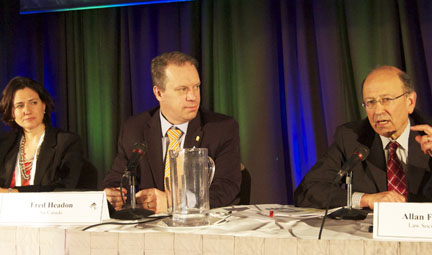Canadian in-house counsel feel they provide the most value to their organizations when managing or reducing risk but often feel they are weighed down by the daily grind, according to this year’s In-House Counsel Barometer Survey.

When it comes to how in-house counsel feels they provide value the majority of respondents (72 per cent) cited risk management, followed by helping achieve strategic and operating objectives (45 per cent) and providing strategic advice (43 per cent) as the key form of value their legal department provides their organization.
Created in conjunction with Vision Critical, the Canadian Corporate Counsel Association and Davies Ward Phillips & Vineberg LLP’s 2013 In-House Counsel Barometer Survey polled 236 members of the CCCA. The annual survey looks at current attitudes and options of Canadian in-house counsel.
“There’s also an aspect of mitigating costs and controlling costs for the employer as well,” said Jodi Shanoff of Vision Critical, who presented the research from report as part of a panel discussion at the CCCA’s 25th anniversary Spring Conference in Toronto today.
About one third of those surveyed believe their department has grown over the past year and the same number feel their staff will increase over the next three years. That is a distinct shift from views presented in 2008-09 when in-house were more pessimistic about future growth. The positive outlook is partially due to necessity, with half of the respondents reporting their legal department is not adequately staffed.
When it came to questions around alternative fee arrangements there was “muted enthusiasm” from those surveyed, and an admission that these models are not readily understood by in-house counsel across Canada. It seems in-house like the idea but don’t always understand them, said Allan Fineblit, CEO of the Law Society of Manitoba who spoke on the panel about the survey.
“There are a variety of models out there but we’ve traditionally as lawyers looked at hourly rates as the basis for billing — and criticism abounds — but there are models where retainer agreements build in a bonus systems where the firm gets to share in the success of the case. The feeling from those who employ them is that they are an opportunity for the firm to get some skin in the game and motivate the firm to be efficient,” said Fineblit.
And while the in-house bar has led the idea of focusing on value, the next challenge is looking internally, said Fred Headon, assistant general counsel with Air Canada who spoke on the panel.
“Clients feel they should be able to engage with us in the same way they engage with everyone else in their lives and that means they don’t necessarily want a five-page memo. That is going to be a challenge not only for law firms but us too,” he said.
“I see it within Air Canada where people’s interaction with their lawyers mirrors other interactions with others in their lives and that often involves a message of 140 characters. It’s going to be important that clients feel they are being properly served.”
The survey found there is no expectation in-house will be working with fewer primary law firms but one third said there would be more insourcing.
When it came to the adoption of legal project management techniques it seems project management has not taken hold. Just 23 per cent of legal departments use project management and only five per cent have hired a project manager or trained someone to be a legal project manager.
“It’s not at all widespread yet,” said Shanoff. “Of those who had experience the value is evident. It seems to be finding traction in larger companies but despite what we understand to be a fairly wide push in-house the uptake is still fairly limited.”
New topics introduced to the survey this year included alternative dispute resolution, however use of ADR methods is low across the board — 43 per cent said they had received no training in this area.
“In-house counsel in Canada who have used ADR have generally reported a positive experience but is quite limited and not getting much traction yet,” said Shanoff.
While a large majority of in-house counsel say they would recommend the in-house career path (93 per cent), however when asked about satisfaction with the position, there was a drop off to 53 per cent who said they are satisfied with their position as in-house counsel.
So what’s bringing in-house down?
• Daily operation work leaves little time for providing strategic value, according to 42 per cent of those who answered.
• 36 per cent say there are insufficient opportunities for promotion.
• 32 per cent say internal business units do not seek timely advice from the legal department.
• 40 per cent say securing approval for additional resources is a challenge.

 When it comes to how in-house counsel feels they provide value the majority of respondents (72 per cent) cited risk management, followed by helping achieve strategic and operating objectives (45 per cent) and providing strategic advice (43 per cent) as the key form of value their legal department provides their organization.
When it comes to how in-house counsel feels they provide value the majority of respondents (72 per cent) cited risk management, followed by helping achieve strategic and operating objectives (45 per cent) and providing strategic advice (43 per cent) as the key form of value their legal department provides their organization.